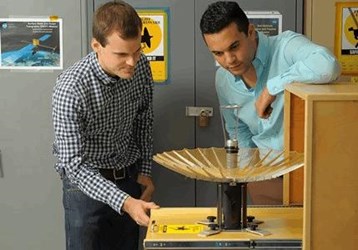NASA Builds Umbrella-Style Antenna For RainCube, MarCO CubeSats
By Jof Enriquez,
Follow me on Twitter @jofenriq

Engineers at NASA's Jet Propulsion Laboratory (JPL) have developed a new folding, umbrella-like antenna design that can be deployed from a canister on a CubeSat – a low-cost mini-satellite slightly larger than a cereal box. The antenna will be used for a demonstration mission as part of NASA's Radar In a CubeSat (RainCube), a climate science and weather-profiling radar.
CubeSats were conceived in the early 2000s as a low-cost satellite platform for testing instruments and running scientific experiments. These spacecraft are cheaper to build and easier to deploy, but present unique challenges, such as requiring miniaturized instruments to fit into a small volume.
For the RainCube satellite, set to be deployed in 2018, the antenna needed to fit into a 1.5 U container (roughly equivalent to a 4-inch cubic box, or 10 cm3). NASA engineers designed it to look like an inverted "umbrella stuffed into a jack-in-the-box; when open, its ribs extend out of a canister and splay out a golden mesh," according to a news release. To maintain its relatively small size, the antenna relies on the high-frequency Ka-band wavelength, which allows the transfer of data rates about 16 times higher than X-band, the current standard on most NASA spacecraft.
"Large, deployable antennas that can be stowed in a small volume are a key technology for radar missions," said JPL's Eva Peral, principal investigator for RainCube. "They open a new realm of possibilities for science advancement and unique applications."
NASA engineers also designed the antenna on board the MarCO (Mars Cube One) CubeSats, whose flyby demonstration is to provide NASA the ability to quickly transmit status information about its InSight spacecraft after the craft lands on Mars in 2018. The engineers put a spin on antenna design with this one: "In place of a round dish are three flat panels dotted with reflective material. The shape and size of these dots form concentric rings that mimic the curve of a dish. Just as a dish might, this mosaic pattern of dots focuses the signal radiated from the antenna's feed towards Earth."
Now, engineers already plan to combine the unique design elements of the RainCube and MarCO antennas to build a bigger antenna: a reflectarray ranging 3.3 feet by 3.3 feet (1 meter by 1 meter), and made up of 15 flat panels.
"These segmented panels would unfold like the flat surface of MarCO's, while the antenna's feed would telescope out like RainCube's antenna. This antenna would be called OMERA, short for the One Meter Reflectarray," stated NASA. OMERA is scheduled for launch in March 2017, and will extend radar communications into deep space.
CubeSats and SmallSats are playing an increasingly larger role in exploration, technology demonstration, scientific research, and educational investigations at NASA. In the future, they could provide improved weather monitoring, ship tracking, and broader Internet coverage. Most CubeSats so far have been launched by the space agency, but last year, it began to offer commercial launch opportunities to promote space-based science missions.
